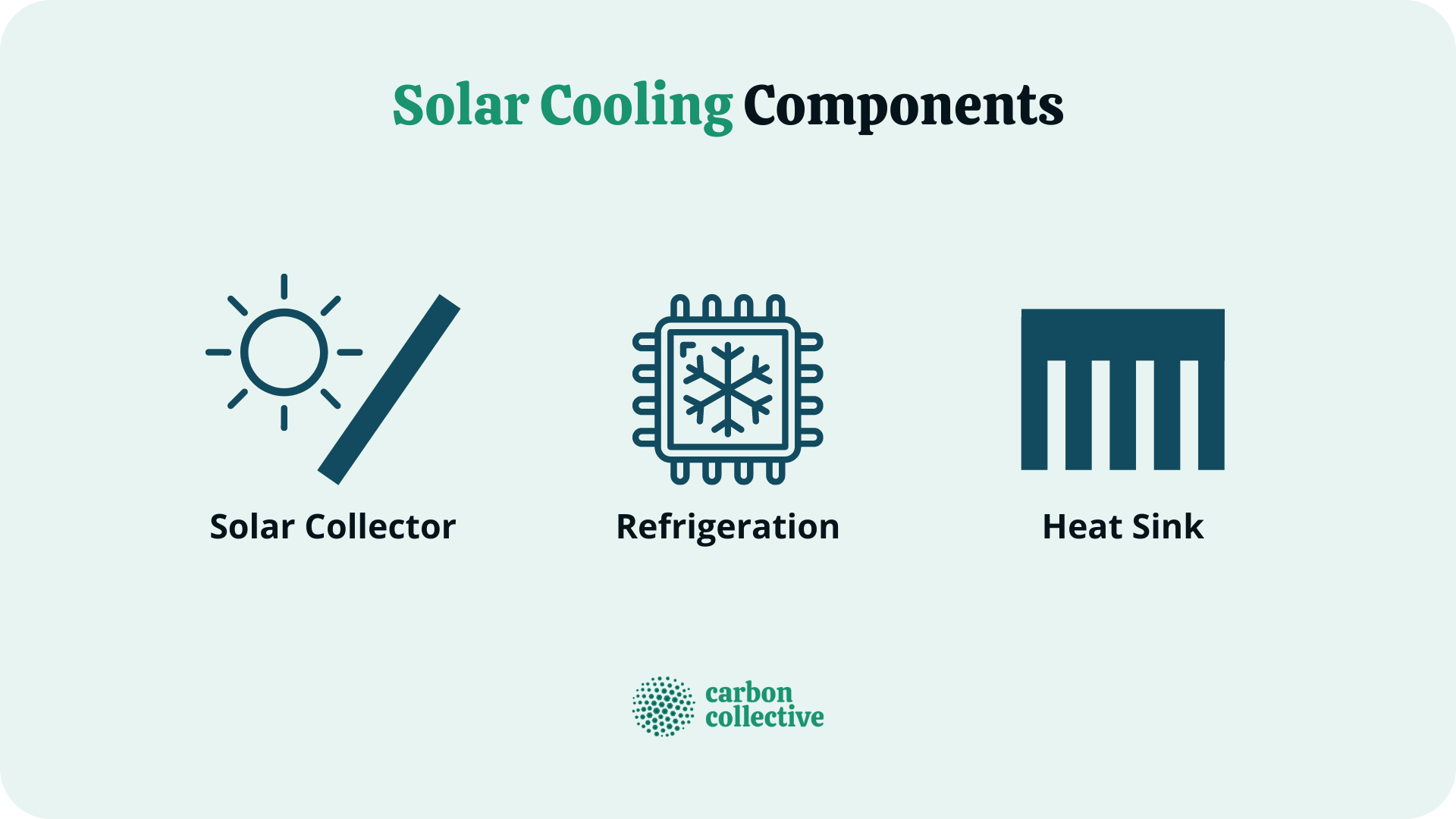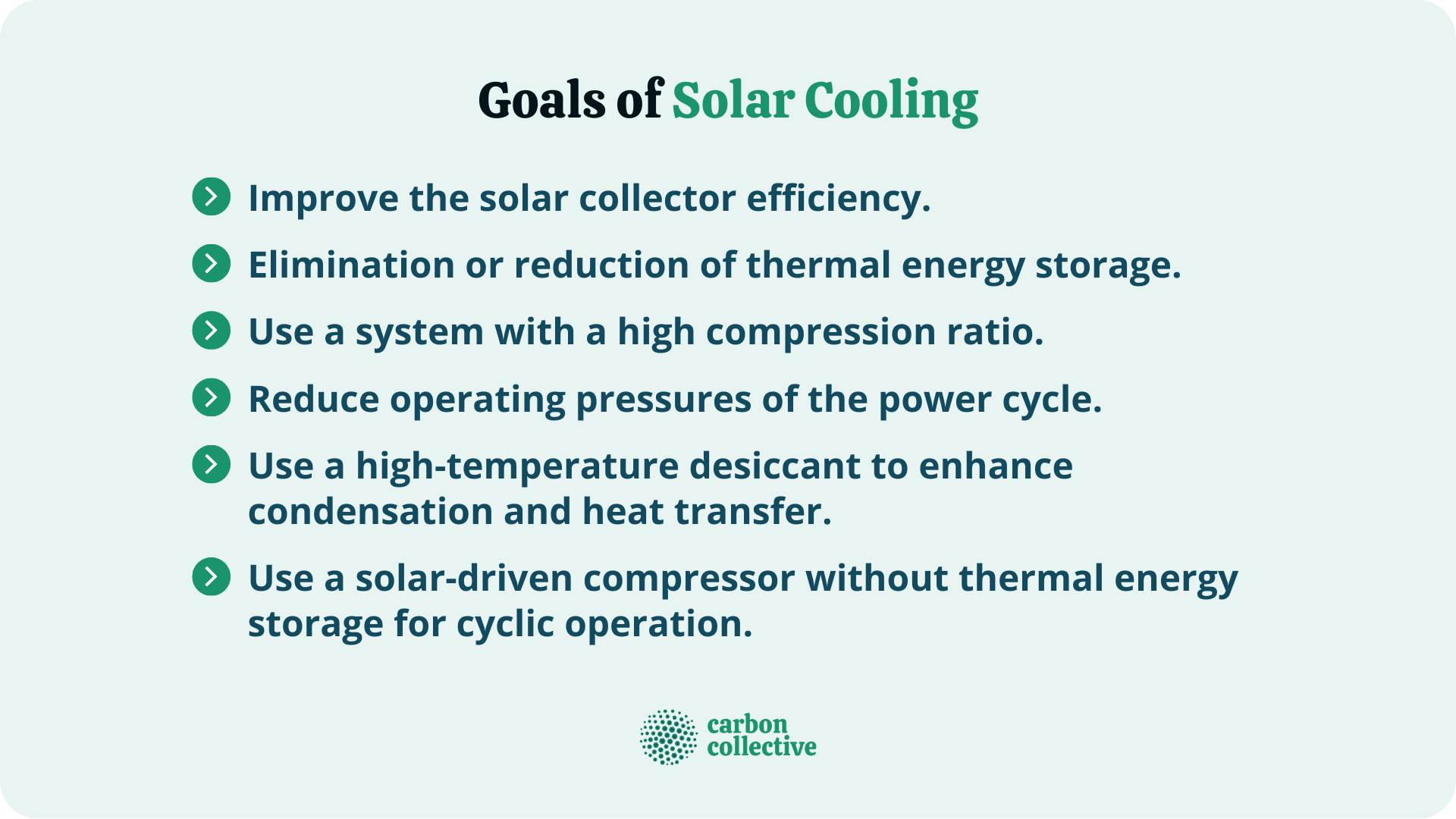Solar Cooling Definition
Solar cooling is the process of cooling a space (and/or heat-sensitive appliances) through a solar thermal collector.
This method uses available clean energy from the sun to power an alternative refrigeration system instead of using traditional nonrenewable sources such as carbon fuels or electricity from conventional energy sources like coal and natural gas.
How It Works
A solar thermal collector is a device that absorbs and transfers heat energy from the sun to an intermediary substance, usually water or air.
The heat-transferring fluid (liquid or air) is then employed in building cooling systems to cool indoor spaces.
Solar Cooling Components
Three major components comprise solar cooling technologies.
Solar Collector
A solar collector is an instrument that absorbs heat from the sun and then transfers it via conduction to a heat-transferring fluid (often water or air).
This system can be used within solar cooling systems for HVAC applications where a compressor is added to the system then employed to cool indoor spaces.
Refrigeration
A refrigeration cycle refers to a process consisting of a vapor compression refrigeration system, a condenser, and a compressor.
The term "refrigeration" is sometimes more loosely used as a term synonymous with air conditioning – which uses a refrigerant as the working fluid – instead of referring to the complete system.
Heat Sink
A heat sink is a structure or object that transfers thermal energy from one place to another without moving the material itself.
Heat sinks are used in electrical components and systems and mechanical components and systems.
The term "heat sink" may refer to a physical object made from materials such as aluminum or copper, or a portion of a larger object may serve as a heat sink.
Techniques to Achieve Solar Cooling
Several techniques can be utilized to achieve efficient solar cooling such as: Absorption Cooling Cycle, Desiccants Cooling System, and Solar Mechanical Cycles.
Absorption Cooling Cycle
Absorption cooling is a process in which a refrigerant such as water or ammonia is combined with a chemical base (NaOH, KOH, LiOH).
The absorption of heat from the space to be cooled causes the chemical solution to become more alkaline. This results in an exothermic reaction that releases hydrogen gas at the cathode and the alkali metal salt remaining in the solution at the anode.
The released hydrogen gas is then pumped to the solar collector heated up by solar radiation. This causes a reaction that converts water to steam, releasing heat energy into the environment.
The endothermic reaction of the chemical base regenerates the refrigerant, which can now be recirculated to the heat sink.
Desiccants Cooling System
A desiccant cooling system works on a similar principle as an absorption cooling system except that it uses a different working fluid – desiccants instead of refrigerants.
A desiccant substance is hygroscopic that induces or sustains a state of dryness in its vicinity.
Various desiccants are used at low-temperature levels, including silica gel. A solar collector absorbs heat from the space to be cooled while simultaneously heating up the desiccant at the same time.
The heated desiccant material is then moved to another chamber where it undergoes a hygroscopic cycle, absorbing moisture from the air.
The captured water or air moisture is then collected in a tank, where it is later released and collected elsewhere to be used for purposes such as plant irrigation.
Solar Mechanical Cycles
A solar mechanical cycle uses a thermochemical reaction that yields a working fluid with a low boiling point, which is used to power a conventional compressor.
A fluid that evaporates at a temperature of around 10°C, such as butane or propane, is heated by solar radiation. The heat is passed onto the working fluid with an organic Rankine cycle.
The Rankine cycle uses a series of closed-loop tubes, which turn water into a gaseous state and then back into a liquid.
The cycle powers a traditional compressor through a vapor-compression refrigeration system. The evaporation of the working fluid results in the indoor space being cooled by removing heat from it.
Goals of Solar Cooling
To achieve efficient solar cooling, several goals must be considered:
Benefits of Solar Cooling
Several benefits can be achieved from using solar cooling:
- Large potential markets, such as urban and commercial buildings, use or produce large amounts of cooling.
- Reduced peak load on existing power systems and reduced environmental impact.
- Alternate use of the cooling system between day and night (hybrid solar cooling) can be used as an auxiliary or primary system for buildings that require continuous cooling during the day and night.
- Unique design, aesthetics, and functionality possibilities.
Challenges of Solar Cooling
Several challenges must be addressed for solar cooling to become a more accessible and practical means of cooling:
- Maximization of the efficiencies of photovoltaics, absorption cooling, and solar-driven compression cycles.
- Research to improve high-temperature desiccants.
- Development of high-efficiency, high-temperature solar collectors.
- Energy storage for overnight cooling requirements in buildings not equipped with hybrid solar cooling systems.
- Research into a new flat plate and evacuated tube solar collector designs, which can reduce costs, improve efficiencies, and reduce installation space requirements.
- Development of high-temperature flat plate collectors that can utilize low-cost thermal energy storage materials, such as Rockwool or expanded clay, used in solar heating systems.
- Research into the water used for cooling (i.e., dry cooling) to reduce the need for water consumption from cooling towers.
Conclusion
Solar cooling technologies hold the potential to reduce the energy consumption and environmental impact of cooling systems and provide a means of nighttime cooling for buildings that do not have sufficient roof space or orientation to accommodate photovoltaics.
These benefits may become more accessible and widespread through continued research and development.
FAQs
1. What is solar cooling?
Solar cooling is a means of cooling that uses solar energy to power a refrigeration cycle, which creates a cooler indoor environment.
2. What is the difference between solar cooling and solar heating?
Solar cooling differs from solar heating because it does not produce thermal energy but rather low-temperature heat due to the refrigeration process involved in its operation.
3. What are some benefits of using solar cooling?
Some benefits of solar cooling include reduced peak load on existing power systems and reduced environmental impact, and alternate use of the cooling system between day and night (hybrid solar cooling).
4. What are the challenges of solar cooling?
Some challenges of solar cooling include: maximizing the efficiencies of photovoltaics, adsorption cooling, and solar-driven compression cycles—research to improve high-temperature desiccants and development of high-efficiency, high-temperature solar collectors.
5. How is solar cooling different from photovoltaics?
Solar cooling typically provides chilled water or refrigeration, while photovoltaics includes electricity.


